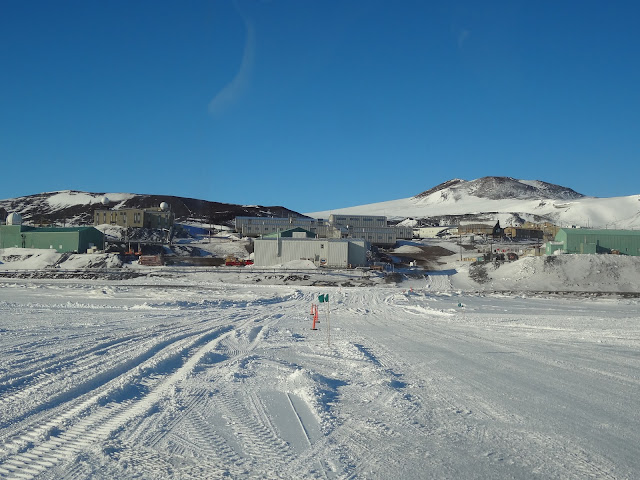Back in the Pisten Bully we head over to an "Apple" - which is a sort of hut around the corner near Scott Base where the New Zealanders reside. That's me below in the passenger seat wearing my circa 1993 style ski glasses so that I'm not blinded by the snow.
Here is Scott Base - it's much smaller than McMurdo. The Americans and Kiwis work together often and share resources as necessary:
It was a very windy - but brilliant day as you can see here. We park, unload and shuffle inside.
Apple #3 here has been placed over a dive hole that's been pre-drilled. Just as before, we use the designated dive hole for fishing.
With most of our team in this shot you get a reference for scale here. The door is quite awkward and wants to slam shut with the wind.

Here are the 3 wind turbines placed above McMurdo - which apparently make up the world's southernmost wind farm - see article: http://cleantechnica.com/2010/01/16/worlds-southernmost-wind-farm-now-feeding-antarctic-grid/
The clouds are a strange texture here:
We head inside of the Apple which blocks you from the wind - but does not have a constant source of heat running as some of the more substantial huts (posted earlier) do.

Given the fact that we are fishing and coming into contact with the freezing cold water, ice and super cold fish - it's a strong preference to have some way to quickly warm your fingers back up if possible. I'm proud to say that I got this bad boy below started - which wasn't actually very straight forward.

Warmth!

Brad standing in the Apple fishing.
We had no luck here - apparently there is a nearby seal that also uses this hole to come up for air. Also, seals eat fish... The divers let us know that the few that are still below - smartly, seem to be hiding.
The ceiling of the apple:
A very McMurdo set of instructions - Mac Ops stands for McMurdo Operations - the radio communications center.
The door from the inside:
Just in case...
Icy apple window:
This was the flagged route we drove down to get here - it's hard to see but just to the right of the very last flag - is actually a C-17 plane landing I believe - on the sea ice with more goods and people to offload.
Heading back - fishless - but happy.

A final view of the kiwi Scott Base. Americans can go to the store to purchase things - but only are allowed on the rest of the base when specifically invited. They hold "American Night" frequently.
To the library...
We decide to set up our pop-up ice tent in the library.

Then I give a speech.


A very Antarctic selection of books:










































































